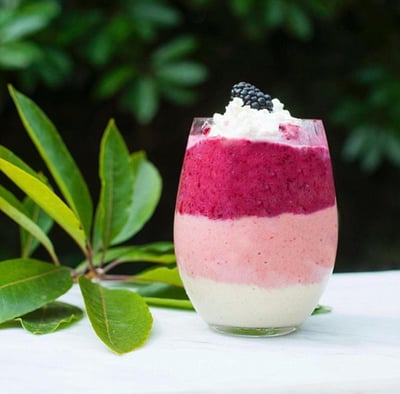Lemon coffee. Birch water. Shrubs.
Where do beverage trends come from, anyway? Often, it’s a collision of big consumer trends and individual innovation. In recent years, the beverage industry have seen consumers turn away from sugar; embrace drinks billed as all-natural, organic or clean; and expect the ability to customize drinks to their preferences. Millennial consumers, in particular, crave novelty: 40 percent are “bored with standard fruit and juice flavors,” a 2016 Fona report found. Then, too, there’s the Instagram factor. Beverages that are unusual, beautiful or colorful (see “smoothie stacks,” below) have greater potential of catching on.

Here’s our take on nine non-alcoholic beverage trends that may become mainstream in 2017.
1. Spiced and stacked smoothies.
Instagram is responsible for one new smoothie trend: the smoothie stack. This is a concoction made from different-colored smoothies that are carefully layered in a jar or glass, resembling a fruit rainbow. Will the smoothie stack make the leap from social media to café menus? Time will tell. This may be the healthy successor to the over-the-top “freakshake” trend we covered in 2016.
The popularity of green smoothies, which include veggies like spinach and cucumbers, will continue as consumers try to cut back on sugar and amp up vegetable consumption. Smoothie fans still seek flavor novelty, notably with herbs (like basil, parsley and mint), spices (such as turmeric and ginger) and less familiar fruits, like dates and guava.
2. Cold-brewed coffee.
Say goodbye to the steamy hiss of the coffee maker. Cold-brewed coffee, the result of steeping ground coffee in chilled or room-temperature water for 12 to 24 hours, is a beverage trend that’s suddenly everywhere. The flavor is rich, less acidic and a little sweeter than traditionally brewed coffee. Starbucks began serving cold-brewed coffee with a bubbly nitrogen kick in 2015. And there’s room for demand to grow: the National Coffee Association recently found that only 15 percent of consumers have ever tried cold-brewed coffee.
3. Coffee lemonade.
Lemon and coffee don’t seem like they’d get along. But when combined over ice in just the right proportion, they twirl around in a flavor tango. The Almond Palmer, invented by Stand Coffee, has taken Brooklyn by storm with its combination of lemon syrup, cold-brewed coffee and almond milk over ice. Other coffee shops add espresso to lemonade or lemon juice.
4. Aguas frescas.
Long popular in Mexico and Los Angeles, aguas frescas are so simple and refreshing that it’s surprising they haven’t boomed sooner. Blend fruit with water, strain out the pulp or seeds, add a little sugar and lime juice — that’s it. Here’s a recipe that uses watermelon.
5. Matcha.
Matcha is an ancient beverage: green tea leaves that are carefully harvested, finely ground and ritually whisked with hot water. Its antioxidants and amino acids have made matcha popular — maybe a little too popular. Grub Street laments how matcha is being added to everything from beer to croissants, “essentially reducing it to the level of pumpkin spice.” When brewed correctly, matcha can be so much more.
6. Shrubs/drinking vinegars.
Does the thought of sipping vinegar make your mouth involuntarily pucker? You’ll be pleasantly surprised by the taste of shrubs. Shrub syrup is made with fresh fruit, sugar and vinegar that complements the fruit. Pour over ice with sparkling water or seltzer, or add to alcoholic drinks. Shrub Drinks suggests stirring syrup into vinho verde for a drink called The Britannia. Shrubs also add vibrancy to hot drinks. Add apple-spice shrub to cider, with a few dashes of orange and lemon juice, simmer with a cinnamon stick and serve. It’s called the Texas Hottie.
7. Birch water.
Used as a health tonic in Russia for centuries, birch water began appearing in the United States a couple of years ago. It’s made from the sap of birch trees, is slightly sweet and contains minerals like potassium and zinc. Birch water may be poised to become a trendy drink in 2017; one sign is the recent launch of Treo, a bottled and fruit-flavored version developed by the son of a Snapple founder.
8. Craft mocktails.
Even non-drinkers want to experience mixologists’ magic, so artfully made mocktails are cropping up on menus. “It’s sort of like the next incarnation of soda. People don’t want to view it as soda, but as a cocktail. It’s like an adult Shirley Temple,” Liz Moskow, culinary director at Sterling-Rice Group, tells Food Business News.
9. Craft sodas.
Traditional sodas are in decline: Soda consumption fell to a 30-year-low in the United States in 2016, Fortune reports. But we’re not giving up the fizz yet. Craft sodas, which are made with sugar, other natural sweeteners (no corn syrup) and natural flavors, are attracting ingredient-conscious consumers who still love a sweet fix. Even the big players are getting in on the craft-soda game. In August 2016, Pepsi began selling Stubborn Soda to retailers. It’s a bottled drink made with fair-trade certified sugar, stevia and flavors such as agave-vanilla and lemon berry acai.
Have you invented a beverage that could be a trendsetter in 2017? Tell us about it and we may feature your business in a future post.


